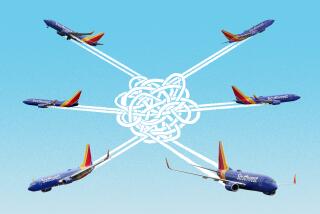Lift Left in Airline Shares?
- Share via
Is there no grounding the rally in airline stocks?
Propelled by strong passenger traffic, rising fares, the sound U.S. economy and lower fuel prices, the airlines just chalked up record profits for the third consecutive year--the first time that’s happened in recent memory. And so investors are bidding the stocks into the clouds.
UAL Corp. (ticker symbol: UAL), the parent of industry leader United Airlines, put the exclamation point on matters two weeks ago by posting a 63% surge in its fourth-quarter profit (excluding one-time items).
That same day, Alaska Air Group Inc. (ALK) weighed with a fourth-quarter profit that nearly doubled from a year earlier. Its stock is at a record high of $50.75.
Together, the airlines have been outperforming the general market by a wide margin. Over the last 12 months, the American Stock Exchange’s airline index has buried the benchmark Standard & Poor’s 500 index with a gain of 86% versus 29%.
And there don’t appear to be clouds on the airlines’ financial horizon, executives and analysts say. The major U.S. carriers continue to report “load factors”--that is, the percentage of their seats that are filled--at a strong 65%-70%, and so they “look set to equal or exceed 1997’s record performance,” said analyst Jeffrey Long of J.P. Morgan Securities Inc.
But not by much, according to Long and others. Expectations of slower U.S. economic growth later this year, Asia’s economic turmoil and the stocks’ run-ups have made market trackers picky about which stocks to buy now.
“We, obviously, are not table-pounders now on these stocks as we were during the summer” of last year, said analyst Steve Lewins of Gruntal & Co.
The airlines themselves are warning of higher costs this year, which could crimp their earnings gains. UAL and AMR Corp. (AMR), the parent of American Airlines, have said their costs could climb as much as 3%.
*
Analysts also see Continental Airlines Inc. (CAI/B)--which last month allied with Northwest Airlines Corp. (NWAC)--facing higher labor costs this year under a new pilots’ contract now in negotiations.
So who’s on the narrowed list of attractive issues?
US Airways Group Inc. (U) is a favorite on Wall Street despite being the sector’s best performer over the last 12 months, with a tripling in price. US Airways was a basket case only a few years ago, but Chairman Stephen Wolf has led the carrier to a major rebound.
US Airways has been hobbled with some of the highest operating costs in the business, but Wolf scored a coup last fall by striking a cost-cutting contract with his pilots. That also paved the way for US Airways to make plans for a new low-cost short-haul subsidiary airline, called MetroJet, and to ink a big order for new, more efficient aircraft.
Hence, the stock is “our best pick for 1998,” Long said.
Lewins agrees, calling it “our single favorite special situation” and noting that “Wolf has done a superb job resolving the carrier’s labor crisis. Now he is going for growth.”
Julius Maldutis, veteran airline analyst at Salomon Smith Barney, also recommends US Airways, because he think it’s “the most attractive candidate” for a strategic alliance with another carrier or an “outright merger.”
Not everyone is high on US Airways. Lehman Bros.’ Brian Harris is neutral, mainly because the stock’s price--at nearly $64 a share--is too rich, he says.
But Harris does like Continental, primarily because he sees “superior” growth potential at the airline’s major hubs in Houston, Cleveland and Newark, N.J. And it’s that growth that will help neutralize the effect of the expected jump in pilot costs, he said.
UAL rates a “buy” from Gruntal’s Lewins. He likes the global reach of United’s route network and the management/employee cooperation stemming from employees’ controlling ownership of the airline. And he considers the Asian economic woes--United, along with Northwest, are the two leading U.S. carriers to Japan--a temporary setback.
But the “Asian flu” is still hurting UAL (and Northwest) for now. UAL Chairman Gerald Greenwald said two weeks ago that United’s international revenue “is expected to remain sluggish as the situation in the Pacific continues to work itself out” in the first quarter.
Northwest, meanwhile, isn’t a screaming buy for many analysts, in good part because the stock has soared 40% just since mid-November, to $56 now. Also hanging over Northwest is that a new U.S.-Japan air accord gives more Japanese access to Northwest’s (and United’s) U.S. competitors.
*
Several analysts are more bullish on AMR, even though AMR stock has surged 65% over the last year. They like American Airlines’ dominant presence in Latin America, the company’s plans to spend part of its $2-billion cash hoard to buy back stock, and AMR’s controlling stake in computer-reservation giant Sabre Group Holdings Inc. (TSG), a formerly wholly owned AMR subsidiary that went public in 1996.
As for low-fare, short-haul king Southwest Airlines (LUV), the Street is split. Some analysts, such as Lewins, recommend it because of Southwest’s steady growth and successful expansion into Florida. But others, such as Harris, think Southwest is fairly priced.
As for the smaller regional airlines, analyst Jordan Sherman of Morgan Stanley, Dean Witter, Discover & Co. has a “strong buy” on Midway Airlines Corp. (MDWY), which went public in December at $15.50 a share. But note: Sherman’s firm was a lead underwriter on the sale and so has a stake in seeing the shares do well.
*
Nonetheless, Sherman said Midway has a strong position at its main hub, at Raleigh-Durham in North Carolina, and a favorable link with powerful American Airlines.
Two other regionals are also posting strong operating results, analysts say: Midwest Express Holdings Inc. (MEH), based in Milwaukee, and SkyWest Inc. (SKYW), a St. George, Utah-based carrier that’s a major feeder to United, among others.
But tread carefully, because these stocks, too, have soared. SkyWest’s stock has tripled in the last 12 months, to $40 now, so gains from here might be harder to come by. And Midwest Express’ stock has jumped more than 80% since last summer to $45.50 now.
It’s true that airline stocks still carry relatively low price-to-earnings multiples. For instance, the Amex airline index’s average P/E is still only 10 based on estimated 1998 earnings per share. That compares with about 22 for the S&P; 500.
But that’s not unusual. Airline shares historically have carried low P/Es because the business is mature and extremely cyclical, meaning the carriers are making money one day and bleeding red ink the next. Hence, investors have long been reluctant to pay even a market-average P/E for profit growth they can’t forecast with much reliability.
*
James F. Peltz can be reached at james.peltz@latimes.com
(BEGIN TEXT OF INFOBOX / INFOGRAPHIC)
AIRBORNE
Airline stocks have surged well ahead of the general stock market over the last year, but analysts are more choosy about which airline stocks they recommend today. Here are the major players:
*--*
Ticker Monday’s % change for Company symbol close last 12 months P/E** Alaska Air ALK $50.75 +128% 12 AMR (American) AMR 130.50 +65 11 Continental CAI/B 50.44 +76 10 Delta DAL 118.75 +46 9 Northwest NWAC 56.00 +69 9 Southwest* LUV 28.94 +97 18 UAL (United) UAL 87.75 +49 9 US Airways U 63.94 +212 12 S&P; 500 + 29 22
*--*
* Reflects 3-for-2 split of Nov.26.
** Price-to-earnings multiple based on 1998 earnings estimates
Source: Bloomberg News
More to Read
Inside the business of entertainment
The Wide Shot brings you news, analysis and insights on everything from streaming wars to production — and what it all means for the future.
You may occasionally receive promotional content from the Los Angeles Times.









